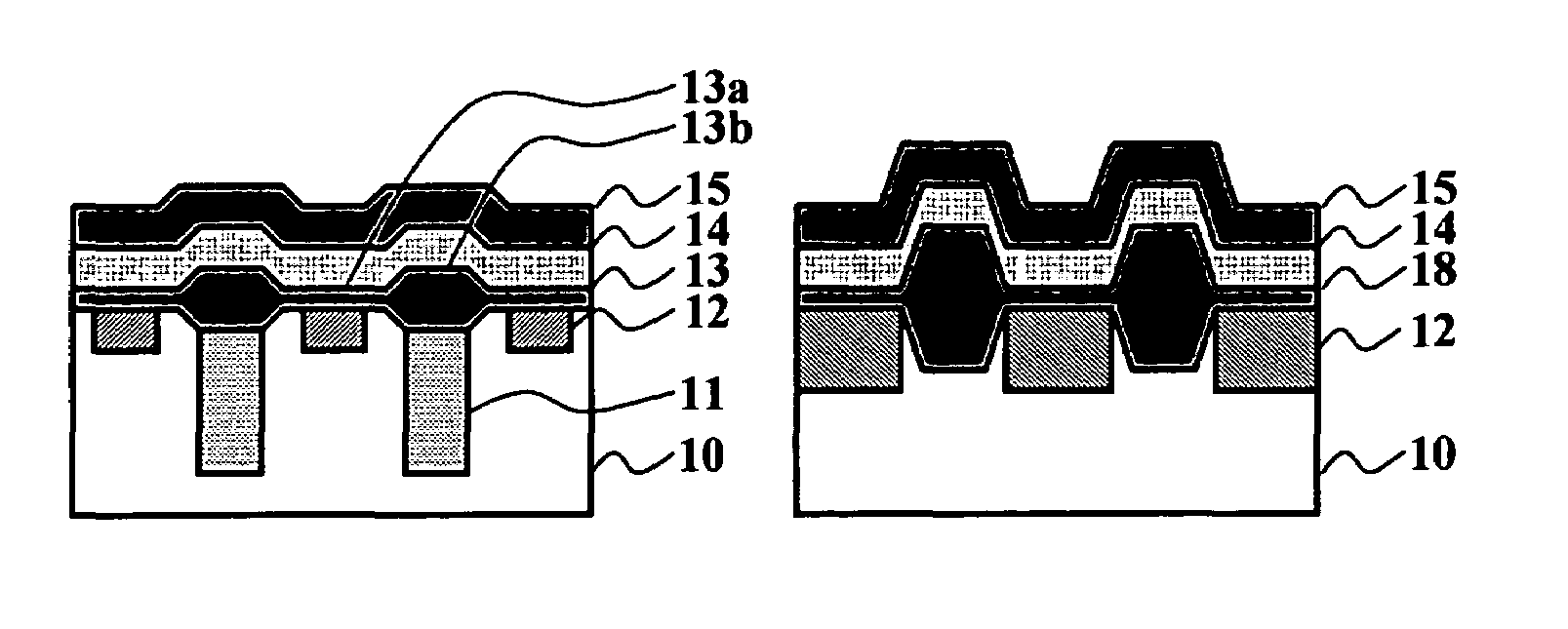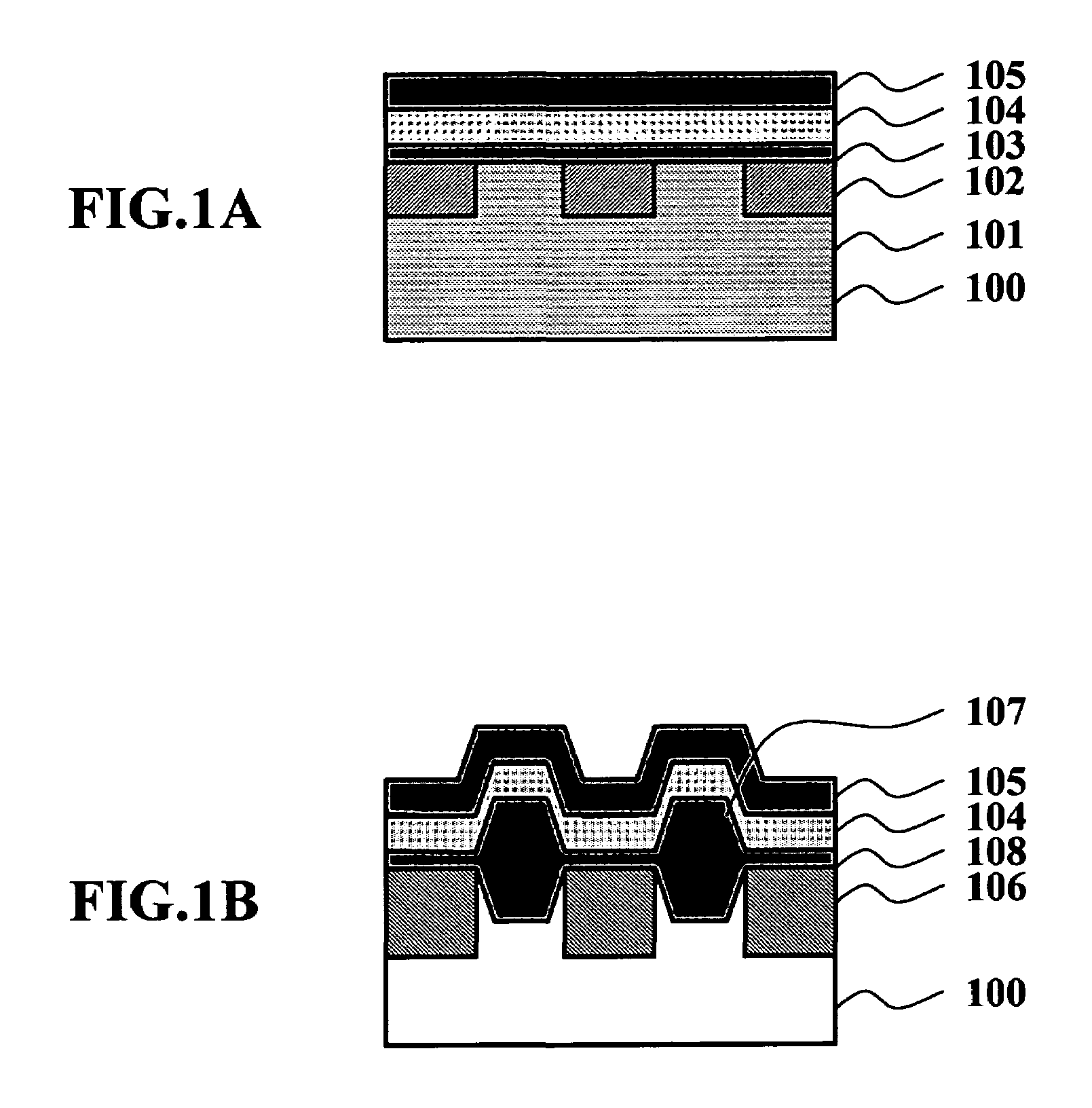Semiconductor device and method of fabricating the same
a technology of semiconductor devices and semiconductors, applied in semiconductor devices, electrical devices, transistors, etc., can solve problems such as data read errors, data leakage, data loss, etc., and achieve the effect of minimizing the structure of the sonos cell without degrading the programming and read performan
- Summary
- Abstract
- Description
- Claims
- Application Information
AI Technical Summary
Benefits of technology
Problems solved by technology
Method used
Image
Examples
first embodiment
[0064]FIGS. 3A and 3B are respectively cross-sectional views of a cell having a first exemplary structure of the semiconductor device of the present invention that has the gate of the SONOS structure and the buried bit line structure. More particularly, FIG. 3A shows the core area, and FIG. 3B shows the cell peripheral area. In the core area, a plurality of cells are arrayed, and each of which cells has the fundamental structure shown in FIG. 2A, and operates as has been described with reference to FIGS. 2B and 2C.
[0065]FIGS. 4A through 6I are views for describing the process of fabricating the present semiconductor device, in which the left-side figures show the core area, and the right-side figures show the peripheral area.
[0066]In the core area, the n-type diffused regions 12 for the bit lines are formed, at equal intervals, on the main surface of the p-type semiconductor substrate 10 through As implantation. Each of the n-type diffused regions 12 functions as the source / drain re...
second embodiment
[0078]FIGS. 7A and 7B are respectively cross-sectional views of the cell having a second exemplary structure of the semiconductor device of the present invention. More particularly, FIG. 7A shows the core area, and FIG. 7B shows the cell peripheral area. FIGS. 8A through 8C show the process of fabricating the present semiconductor device, wherein the left-side figures show the core area and the right-side figures show the cell peripheral area.
[0079]The structure of the cell peripheral area of the semiconductor device is the same as that of the first exemplary structure shown in FIG. 3B. The structure of the core area shown in FIG. 7A differs from that of the first exemplary structure shown in FIG. 3A in that the first structure has the ion-implanted region 11 for the adjustment of the threshold values applied to the whole surface of the semiconductor substrate 10, while the second structure has the ion-implanted regions 11 applied only to the channel regions located between the n-ty...
third embodiment
[0088]The semiconductor device of the present embodiment has a structure similar to that shown in FIGS. 7A and 7B, but has a process for forming the n-type diffused regions different from that employed in the second embodiment.
[0089]FIGS. 9A through 9D describe the process of forming the n-type diffused regions of the present invention, wherein the left-side figures show the core area and the right-side figures.
[0090]The thin oxide film (having a thickness of approximately 7 nm) is uniformly formed on the main surface of the semiconductor substrate 10, and the polysilicon film 19 is deposited on the oxide film 18. Then, the polysilicon film 19 is partially etched by the photolithographic process to form openings arranged at given intervals (FIG. 9A).
[0091]Next, a nitride film is uniformly deposited and is etched to form nitride sidewall films 23 on opposite sides of the patterned polysilicon films 19 arranged on the thin oxide film 18 at given intervals. After that, As ions are impl...
PUM
 Login to View More
Login to View More Abstract
Description
Claims
Application Information
 Login to View More
Login to View More - R&D
- Intellectual Property
- Life Sciences
- Materials
- Tech Scout
- Unparalleled Data Quality
- Higher Quality Content
- 60% Fewer Hallucinations
Browse by: Latest US Patents, China's latest patents, Technical Efficacy Thesaurus, Application Domain, Technology Topic, Popular Technical Reports.
© 2025 PatSnap. All rights reserved.Legal|Privacy policy|Modern Slavery Act Transparency Statement|Sitemap|About US| Contact US: help@patsnap.com



